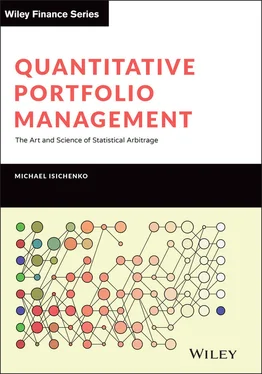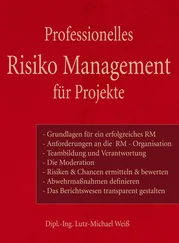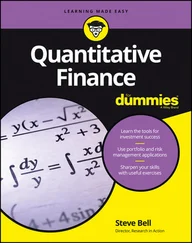Michael Isichenko - Quantitative Portfolio Management
Здесь есть возможность читать онлайн «Michael Isichenko - Quantitative Portfolio Management» — ознакомительный отрывок электронной книги совершенно бесплатно, а после прочтения отрывка купить полную версию. В некоторых случаях можно слушать аудио, скачать через торрент в формате fb2 и присутствует краткое содержание. Жанр: unrecognised, на английском языке. Описание произведения, (предисловие) а так же отзывы посетителей доступны на портале библиотеки ЛибКат.
- Название:Quantitative Portfolio Management
- Автор:
- Жанр:
- Год:неизвестен
- ISBN:нет данных
- Рейтинг книги:4 / 5. Голосов: 1
-
Избранное:Добавить в избранное
- Отзывы:
-
Ваша оценка:
Quantitative Portfolio Management: краткое содержание, описание и аннотация
Предлагаем к чтению аннотацию, описание, краткое содержание или предисловие (зависит от того, что написал сам автор книги «Quantitative Portfolio Management»). Если вы не нашли необходимую информацию о книге — напишите в комментариях, мы постараемся отыскать её.
, distinguished physicist-turned-quant Dr. Michael Isichenko delivers a systematic review of the quantitative trading of equities, or statistical arbitrage. The book teaches you how to source financial data, learn patterns of asset returns from historical data, generate and combine multiple forecasts, manage risk, build a stock portfolio optimized for risk and trading costs, and execute trades.
In this important book, you’ll discover:
Machine learning methods of forecasting stock returns in efficient financial markets How to combine multiple forecasts into a single model by using secondary machine learning, dimensionality reduction, and other methods Ways of avoiding the pitfalls of overfitting and the curse of dimensionality, including topics of active research such as “benign overfitting” in machine learning The theoretical and practical aspects of portfolio construction, including multi-factor risk models, multi-period trading costs, and optimal leverage Perfect for investment professionals, like quantitative traders and portfolio managers,
will also earn a place in the libraries of data scientists and students in a variety of statistical and quantitative disciplines. It is an indispensable guide for anyone who hopes to improve their understanding of how to apply data science, machine learning, and optimization to the stock market.

 through dollar position
through dollar position  :
:


 , or a basis point (bps), which is in the ballpark of the return predictability ( Sec. 2.3.3). The expectation, or forecast, of the log return (1.10)is
, or a basis point (bps), which is in the ballpark of the return predictability ( Sec. 2.3.3). The expectation, or forecast, of the log return (1.10)is
 is the volatility (standard deviation) of the return. Due to the negative sign of the correction in (1.11), its effect can be meaningful even for a slightly non-dollar-neutral or volatility-exposed portfolio. Volatility is one of commonly used risk factors (Sec. 4.3).
is the volatility (standard deviation) of the return. Due to the negative sign of the correction in (1.11), its effect can be meaningful even for a slightly non-dollar-neutral or volatility-exposed portfolio. Volatility is one of commonly used risk factors (Sec. 4.3).










